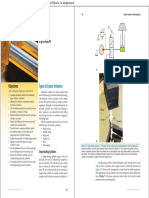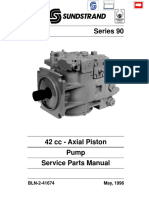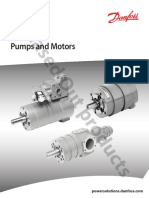Hydraulic Training Courses
Hydraulic Training Courses
Uploaded by
darthvader909Copyright:
Available Formats
Hydraulic Training Courses
Hydraulic Training Courses
Uploaded by
darthvader909Copyright
Available Formats
Share this document
Did you find this document useful?
Is this content inappropriate?
Copyright:
Available Formats
Hydraulic Training Courses
Hydraulic Training Courses
Uploaded by
darthvader909Copyright:
Available Formats
Basic level training:
Design, function and most important characteristics of a hydraulic power unit
Design and function of pressure-relief valves, cylinders and directional control valves
Design and function of the non-return valve, one-way flow control valve and piloted
non-return valve
Design and function of flow control valves
Measurements and calculations:
Recording and interpreting the characteristic curve of a hydraulic pump
Measuring the volume flow of a hydraulic control system
Recording the characteristic curve of a pressure-relief valve
Identifying and calculating times, pressures and forces during advancing and
retracting of a cylinder
Recording the characteristic curve of a flow control valve
Calculating performance ratios when using 4/3-way valves with different mid-
positions
Hydraulic circuits:
Commissioning hydraulic circuits safely
Using the flow control valve in the inflow and outflow and adjusting the drive speed
Difference between a flow control valve and one-way flow control valve in hydraulic
control systems
Design and mode of operation of a differential circuit
Effect of the piston surfaces on pressures, forces, speeds and travel times
Proper use of piloted non-return valves
Circuits with different types of counter pressure
Operating cylinders with varying loads
Advanced level training: troubleshooting
Systematic troubleshooting and professional error elimination are an essential part of
everyday operating life in many jobs in the fields of mechanics, mechatronics and electrical
engineering. In order to acquire a skills in this area via a structured procedure that takes into
account safety aspects, it is important that systematic troubleshooting is both learned and
practiced. Key to this are:
Understanding circuits and discerning any non-conformities
Delimiting/precluding any error areas
Locating and rectifying errors
This procedure assumes specialist knowledge such as modes of operation of individual
components and their system limits.
Pressure relief valve with broken spring
One example of a defective component is a pressure relief valve with a broken spring. This
defect may be due to a continuous load or a material flaw. The defect results in the spring
length being shortened and hence in a reduction in the maximum pressure that can be set. The
conspicuous symptoms result in a lower cylinder force. Pressure sensors or force sensors may
not switch, which can lead to interruptions to operation cycles or process safety being put at
risk.
Flow control valve with damaged pressure compensator
Another example of a defect is a two-way flow control valve with a damaged pressure
compensator. While intact, the valve ensures a constant volumetric flow rate, regardless of
the load pressure. The pressure compensator is not working in this case however. The
differential pressure is no longer being regulated via the throttle valve. Here, the flow control
valve behaves like an unregulated throttle valve. A fault like this occurs if dirt has entered the
system and the pressure compensator's piston has seized up in open position as a result.
Requirements
Building on from Basic Level Hydraulics, the Advanced Level contains eight components
appropriate for equipment set TP 501. Possible troubleshooting tasks are aimed at all job
areas involving maintenance and repair activities. Special measuring equipment is not
assumed since all symptoms can be observed and are therefore visible. Error patterns can also
be quantified using measuring equipment such as a flowmeter or pressure gauge however.
The most important components at a glance
Shut-off valve, defective
One-way flow control valve, defective
Pressure relief valve, defective
2-way flow control valve, defective
4/3-way hand lever valve, H-center position, detenting (PTAB)
Flow control valve
Differential cylinder 16/10/200, defective
Tubing line with quick connection coupling, clogged
Closed loop hydraulics: basic training:
Hydraulic closed-loop control circuits are normally operated with continuous valves. A
control valve with integrated electronics, linear characteristic curve (volumetric flow to
control piston position) and zero overlap makes commissioning easy and provides good
results in the closed-loop control circuit.
Training content
Position control circuits:
Characteristic curve of a displacement sensor
Flow rate characteristics of a continuous directional control valve
Linear unit as a controlled system for position control
Designing and commissioning a position control circuit
Lag errors in the position control circuit
Position control with a changed controlled system
Commissioning a position control circuit with disturbances
Characteristics and transition functions of a status controller
Parameterising a status controller
Pressure control circuits:
Characteristic curve of a pressure sensor
Controlled system for pressure control
Characteristics of a PID controller board
Transition function of a P controller
Control performance of a pressure control circuit with P controller
Transition functions of I and PI controllers
Transition functions of D, PD and PID controllers
Empirical parameterisation of a PID controller
Parameterising using the Ziegler-Nichols method
Changed controlled system with disturbances
Controllers in hydraulics:
Controlled systems with and without compensation
Low-delay hydraulic controlled systems
First, second and third order hydraulic controlled systems
Classifying controlled systems according to their step response
Operating point and controller amplification
Discontinuous controllers
Block diagrams for discontinuous and continuous controllers
P, I, D, PI, PD and PID controllers
Status controllers
Selecting the controller structure
Disturbance reaction and control factor
Designing control circuits
Hydraulic, mechanical and electrical controllers
Analogue and digital controllers
Selection criteria for controllers
Valves and measuring systems:
Designation, circuit symbols and function of continuous directional control valves
Stationary characteristics and dynamic behaviour of continuous directional control
valves
Function, design and mode of operation of a pressure regulating valve
Pressure control with a directional control valve
Mode of operation and interface of a measuring system
Recommendations for accessories, media and extensions
Hose line with quick release couplings
Hose line with quick release couplings
Hose line with quick release couplings
Hose line with quick release couplings
Pressure relief unit
Function generator
Cable BNC – 4 mm
Cable BNC – BNC
T-piece BNC
4 mm Safety laboratory cables, 106 pieces, red, blue, and black
Aluminum profile plate
Hydraulic power pack with two constant-displacement pumps and one motor
Power supply unit for mounting frame
Closed-loop hydraulics: Workbook
The most important components at a glance
PID controller
Status controller
Pressure sensor
Pressure gauge
Hydraulic motor
Flow sensor
Pressure filter, 5 μm
Flow control valve
Shut-off valve
4-way distributor with pressure gauge
T-distributor
4/3-way regulating valve
Linear drive
Weight, 5 kg, for linear drive
Advanced training electrohydraulic:
Training content
Power packs and components:
Design and mode of operation of different proximity sensors
Function and possible applications of a time relay with switch-on and switch-off delay
Design and use of an electrical predetermining counter
Learning objectives for hydraulic circuits:
Selecting proximity sensors according to the technical control requirements
Expanding electrohydraulic control systems and adjusting the documentation
Designing and arranging path- and pressure-dependent sequence controls
Identifying signal overlaps in a sequence control and taking the appropriate action
Designing and arranging sequence control as a standing sequencer
Using memory to implement an emergency operation
Implementing control systems with the operating modes single cycle and continuous
cycle
Querying time in electrohydraulic control systems
Getting to know and using further logical connections
Designing and arranging pressure sequence control
Knowing safety-related conditions that could be needed for a drive
Designing and arranging safety functions with a predefined motion sequence for a
control system
Implementing control systems with the operating modes inching and aligning
Systematically identifying and eliminating errors in complex electrohydraulic control
systems
Creating sequence control as a displacement-step diagram
Representing procedure descriptions with GRAFCET
The most important components at a glance
Time relay, two-fold
Relay, three-fold
Preset counter, electronic
Diaphragm accumulator with shut-off block
Hydraulic motor
4/3-way solenoid valve, relieving mid-position (AB −> T)
Proximity sensor, inductive, M12
Emergency stop pushbutton, electrical
T-distributor
Non-return valve, delockable (Order no. 544339)
Pressure relief valve, compensated (Order no. 567237)
You might also like
- TV Philips Service Manual 32pfl6087h12Document165 pagesTV Philips Service Manual 32pfl6087h12bigjoe20% (1)
- QL Technical Manual LOWresDocument44 pagesQL Technical Manual LOWresajayNo ratings yet
- 07 Donaldson HPK04 Series Data SheetsDocument4 pages07 Donaldson HPK04 Series Data SheetsCarlos Mauricio RodríguezNo ratings yet
- Excava e PDFDocument22 pagesExcava e PDFFaserphi SacNo ratings yet
- E 265B-E 305B Hydraulic DiagramsDocument10 pagesE 265B-E 305B Hydraulic DiagramsOscar VazquesNo ratings yet
- Combination Module PVGI Tech NoteDocument8 pagesCombination Module PVGI Tech NoteHYDRAULICGURU100% (1)
- Manual Hidraulico Top Drive JH 250 TonDocument176 pagesManual Hidraulico Top Drive JH 250 Tonjdjd69486gmail.comNo ratings yet
- Manual GDocument84 pagesManual GTri Maizon100% (1)
- ch06Document16 pagesch06Mahmmod Al-QawasmehNo ratings yet
- Tcr-10000 Coil Tubing Unit Operation and Maintenance Manual Hydraulic SystemDocument12 pagesTcr-10000 Coil Tubing Unit Operation and Maintenance Manual Hydraulic SystemOvRrj AhmedNo ratings yet
- Hydraulic Remote ControlsDocument64 pagesHydraulic Remote Controlswalk111100% (1)
- Maflosh 02 IngDocument44 pagesMaflosh 02 IngNicoleta Costea100% (1)
- Sundstrand 90 Series 42cc Pump Service Parts ManualDocument86 pagesSundstrand 90 Series 42cc Pump Service Parts ManualAyaz Shahbazov100% (1)
- Product Information: Model 8035E Top DriveDocument4 pagesProduct Information: Model 8035E Top DriveDenis Agarkov100% (2)
- Pump, Description: Model CodeDocument4 pagesPump, Description: Model CodeNaing Min HtunNo ratings yet
- Chino70hydraulic ManualDocument43 pagesChino70hydraulic Manualcarlos moyaNo ratings yet
- Abmaxx Large Modular HPU: Technical InformationDocument16 pagesAbmaxx Large Modular HPU: Technical InformationHanzil HakeemNo ratings yet
- Hydraulic System: Dictionary of Pictograph SymbolsDocument7 pagesHydraulic System: Dictionary of Pictograph SymbolsalexarauNo ratings yet
- L7 - Hydraulic Motors and AccumulatorsDocument33 pagesL7 - Hydraulic Motors and Accumulatorsu1909030100% (1)
- 03 Hydraulic Unit of Step Less Capacity Control of Reciprocating Compressors.Document5 pages03 Hydraulic Unit of Step Less Capacity Control of Reciprocating Compressors.sumantabal_uceNo ratings yet
- General Service Manual 1320 OnlyDocument74 pagesGeneral Service Manual 1320 OnlyNOUR ZAINNo ratings yet
- Hydrapac Company Profile HPDocument2 pagesHydrapac Company Profile HPDragan Lazic100% (1)
- HPFi Hydraulic Support System 0700Document35 pagesHPFi Hydraulic Support System 0700g665013No ratings yet
- Rig 12 Inventory SummaryDocument3 pagesRig 12 Inventory Summaryherysyam1980100% (1)
- Rohm Lathe ChucksDocument91 pagesRohm Lathe ChucksNebojša ObradovićNo ratings yet
- Colores de CablesDocument36 pagesColores de CablesJohn SuarezNo ratings yet
- Pilot Operated Directional Control ValvesDocument18 pagesPilot Operated Directional Control ValvesEng-Mohammed Salem100% (1)
- Crane Main Directional Control ValveDocument4 pagesCrane Main Directional Control ValveMiguel100% (1)
- Pumps and Motors: Phased Out ProductsDocument56 pagesPumps and Motors: Phased Out Productsmanuele garulli100% (1)
- Engineering Bill of Material-1-111Document111 pagesEngineering Bill of Material-1-111Abdellah AbdellahNo ratings yet
- 4/3 and 4/2 Directional Control Valves With Hand Lever Type WMMDocument8 pages4/3 and 4/2 Directional Control Valves With Hand Lever Type WMMAhmed Abd Elhakeem100% (1)
- PVEU - PVE For 0-10V Voltage Control: Confidential InformationDocument12 pagesPVEU - PVE For 0-10V Voltage Control: Confidential InformationbrunosamaeianNo ratings yet
- Hydraulic Fault FindingDocument9 pagesHydraulic Fault Findingkukuriku13No ratings yet
- Bladder-Type Accumulator HAB: RE 50170/03.2014, Bosch Rexroth AGDocument20 pagesBladder-Type Accumulator HAB: RE 50170/03.2014, Bosch Rexroth AGShariq KhanNo ratings yet
- Manual de Panther T8 2013Document347 pagesManual de Panther T8 2013Anonymous Hd32bhqNo ratings yet
- Model Zq127/25y Drill Pipe Power TongDocument26 pagesModel Zq127/25y Drill Pipe Power TongJoseph YaoNo ratings yet
- Hyd SymbolsDocument1 pageHyd SymbolsAdi Surya Herysusanto100% (2)
- B1 E-Load-Sensing Tractors enDocument11 pagesB1 E-Load-Sensing Tractors enwalk001No ratings yet
- D391000587 MKT 001 PDFDocument32 pagesD391000587 MKT 001 PDFDwiki RamadhaniNo ratings yet
- Basis-Hydraulik EN PDFDocument29 pagesBasis-Hydraulik EN PDFMunteanu Bogdan-Cristian100% (1)
- Engine Oil Filter 3126BDocument3 pagesEngine Oil Filter 3126BGerardo Velazquez100% (1)
- Chapter 4 Hydraulic PumpsDocument40 pagesChapter 4 Hydraulic PumpsMohammed Al-OdatNo ratings yet
- Basic Finlay Hydraulics - REV00 - 20090629 PDFDocument15 pagesBasic Finlay Hydraulics - REV00 - 20090629 PDFJose TorresNo ratings yet
- The Basic Principles of HydraulicsDocument8 pagesThe Basic Principles of Hydraulicsyakarim100% (3)
- E Piston Pump (Main)Document4 pagesE Piston Pump (Main)wong apian100% (1)
- Control System SY DFEE: Projecting Guidelines and Commissioning InstructionsDocument26 pagesControl System SY DFEE: Projecting Guidelines and Commissioning InstructionsMustapha AlaouiNo ratings yet
- Directional Control ValvesDocument18 pagesDirectional Control Valvesdoan luc100% (1)
- BLN 9884Document24 pagesBLN 9884Rachan Engchanil100% (1)
- Service Instructions: Oilgear Type "PVV 540" Open Loop PumpsDocument14 pagesService Instructions: Oilgear Type "PVV 540" Open Loop PumpsAxel LetonaNo ratings yet
- Specifying The Right Hydraulic Cylinder For The Right JobDocument8 pagesSpecifying The Right Hydraulic Cylinder For The Right JobJosh WhiteNo ratings yet
- 432d Signal Resolver Network - CheckDocument6 pages432d Signal Resolver Network - CheckDiego CatariNo ratings yet
- Hawe PDFDocument262 pagesHawe PDFmadan mohan katta0% (1)
- Rehs1761-06 Required Tooling For Bench Testing Hydraulic Components 13-07-2012Document22 pagesRehs1761-06 Required Tooling For Bench Testing Hydraulic Components 13-07-2012Jean-Jacques OuandaogoNo ratings yet
- Delmag RH Reihe enDocument20 pagesDelmag RH Reihe enIvanNo ratings yet
- Katalog Hagglunds Motor CBM TypeDocument28 pagesKatalog Hagglunds Motor CBM TypeRudianto SakkaNo ratings yet
- Festo VPPM Fast Switching SolenoidsDocument58 pagesFesto VPPM Fast Switching Solenoidst8e7w2koNo ratings yet
- Mechatronics Lab Manuaol 2Document130 pagesMechatronics Lab Manuaol 2prabu51No ratings yet
- Ihp Unit 6: Pneumatic CircuitsDocument35 pagesIhp Unit 6: Pneumatic CircuitsAkash MarkhaleNo ratings yet
- Instrumentation & Control and Control Valves CoursesDocument11 pagesInstrumentation & Control and Control Valves CoursesNej SaNo ratings yet
- H & P SyllabusDocument3 pagesH & P SyllabusDrPrashant NeheNo ratings yet
- Practices Manual: 7.1 General Description of The SystemDocument18 pagesPractices Manual: 7.1 General Description of The SystemFricilia Indah PrimasariNo ratings yet
- Design of Two Wheel Inverted Pendulum: JANUARY 19 2020Document13 pagesDesign of Two Wheel Inverted Pendulum: JANUARY 19 2020darthvader909No ratings yet
- 1-Define The Pattern Formation & Mention Two of Its UsesDocument2 pages1-Define The Pattern Formation & Mention Two of Its Usesdarthvader909No ratings yet
- Control and GrafcetDocument4 pagesControl and Grafcetdarthvader909No ratings yet
- GOW NorseDocument1 pageGOW Norsedarthvader909No ratings yet
- Graduation Project Registration Form: Heat Treatment Furnace For MetalsDocument1 pageGraduation Project Registration Form: Heat Treatment Furnace For Metalsdarthvader909No ratings yet
- Sheet 1 Neural NetworkDocument5 pagesSheet 1 Neural Networkdarthvader909No ratings yet
- Agriculture: Definition and Overview: January 2014Document11 pagesAgriculture: Definition and Overview: January 2014darthvader909No ratings yet
- Robotics: Dr. Omar Salah Eldin MahmoudDocument33 pagesRobotics: Dr. Omar Salah Eldin Mahmouddarthvader909No ratings yet
- 1 ChadF 2Document9 pages1 ChadF 2darthvader909No ratings yet
- BT27May 8Document1 pageBT27May 8darthvader909No ratings yet
- AppendicesDocument11 pagesAppendicesLIEW HUI FANG UNIMAPNo ratings yet
- A Review On DC Microgrid Control TechniquesDocument11 pagesA Review On DC Microgrid Control TechniquesAyman KhalfallaNo ratings yet
- Reg. No: Name:: Q.No. Sub. Sec. Question Description MarksDocument2 pagesReg. No: Name:: Q.No. Sub. Sec. Question Description MarksWINORLOSENo ratings yet
- CO-EC Series PDFDocument2 pagesCO-EC Series PDFBernardo Ramos RojasNo ratings yet
- Brochure Victron Energy Quattro IIDocument2 pagesBrochure Victron Energy Quattro IISINES FranceNo ratings yet
- Compound Wound Generator Long & Short Shunt Compound WoundDocument4 pagesCompound Wound Generator Long & Short Shunt Compound Woundmark amthonyNo ratings yet
- Smoke Manual en OPERACION Y SOFWAREDocument58 pagesSmoke Manual en OPERACION Y SOFWAREdanilo adrés amezquita perdomoNo ratings yet
- PHY547 - LAb Manual-2019Document26 pagesPHY547 - LAb Manual-2019zulhaimirasheedNo ratings yet
- Downloaded From:: 01V96-Owner's ManualDocument10 pagesDownloaded From:: 01V96-Owner's Manualzytura2019No ratings yet
- C5 - Lecture 2Document24 pagesC5 - Lecture 2nurul iqinNo ratings yet
- SyllabusDocument2 pagesSyllabusnishantmanderna20No ratings yet
- MCS 012 C.O Imp QuesDocument5 pagesMCS 012 C.O Imp QuesAnupam GyawaliNo ratings yet
- Commissioning Report CD390 1050 Antwerp 2946068800Document3 pagesCommissioning Report CD390 1050 Antwerp 2946068800Naveedullah AwanNo ratings yet
- Applied Physics MTH-108: Dr. Abdul Aleem JamaliDocument10 pagesApplied Physics MTH-108: Dr. Abdul Aleem JamaliHassan AliNo ratings yet
- LT 01Document2 pagesLT 01Abhilash JangidNo ratings yet
- Installation / Wire Connection Guide: Before StartingDocument9 pagesInstallation / Wire Connection Guide: Before StartingDario Eyner Choque CastroNo ratings yet
- Clinical Chemistry Laboratory - SpectrophotometryDocument2 pagesClinical Chemistry Laboratory - SpectrophotometrynikkiNo ratings yet
- Yamaha 300Document54 pagesYamaha 300jonNo ratings yet
- Lyt7503-7504 Lytswitch-7 FamilyDocument12 pagesLyt7503-7504 Lytswitch-7 Familyzuffflor_925748656No ratings yet
- HIB Imoticon User Guide V1.4.0 PDFDocument12 pagesHIB Imoticon User Guide V1.4.0 PDFnicolaecomiciNo ratings yet
- Power Electronics: Single Phase AC-AC ConvertersDocument18 pagesPower Electronics: Single Phase AC-AC ConvertersMaruti MohiteNo ratings yet
- 6 Unitised SubstationDocument2 pages6 Unitised SubstationArif MohiuddinNo ratings yet
- JSB-196GM: 150W MF/HF RadiotelephoneDocument3 pagesJSB-196GM: 150W MF/HF RadiotelephonesajujohnyNo ratings yet
- Compal NM-A581 Lenovo ThinkPad T460S PDFDocument97 pagesCompal NM-A581 Lenovo ThinkPad T460S PDFАааNo ratings yet
- Unit 3 - Multiterminal DC SystemDocument21 pagesUnit 3 - Multiterminal DC Systemkarthik83% (6)
- IES EE C 1993 (Electrical Guru - Blogspot.in)Document11 pagesIES EE C 1993 (Electrical Guru - Blogspot.in)Tanmay PokaleNo ratings yet
- Description: Switch Lights of Remote Touch Do Not IlluminateDocument3 pagesDescription: Switch Lights of Remote Touch Do Not IlluminateJack CardiagNo ratings yet
- Lab 4 PDFDocument4 pagesLab 4 PDFAisha NurymgaliNo ratings yet
- P633 OrderForm - v66 - 112023Document14 pagesP633 OrderForm - v66 - 112023syed ajmalNo ratings yet



































































































